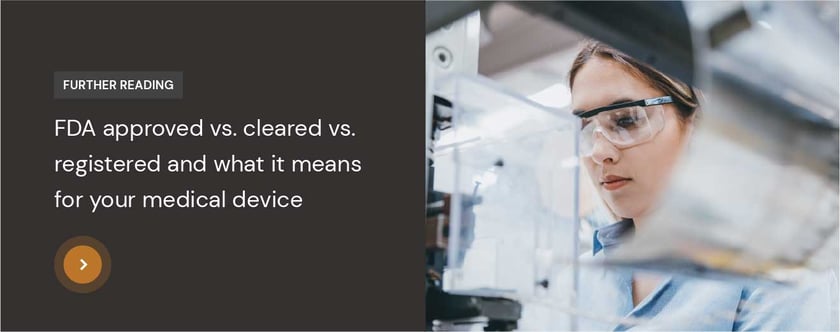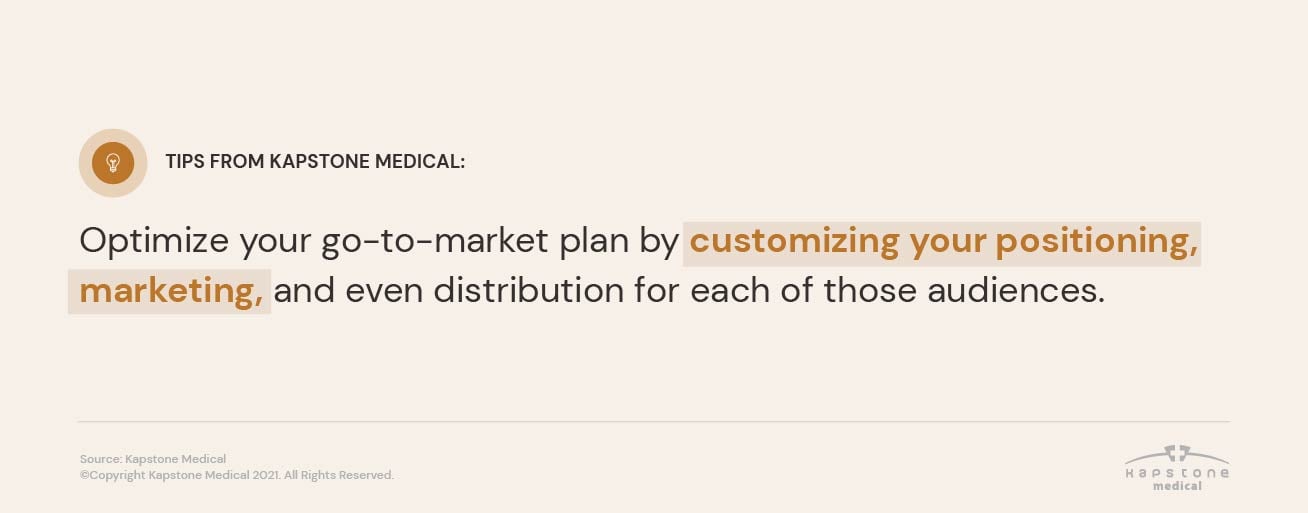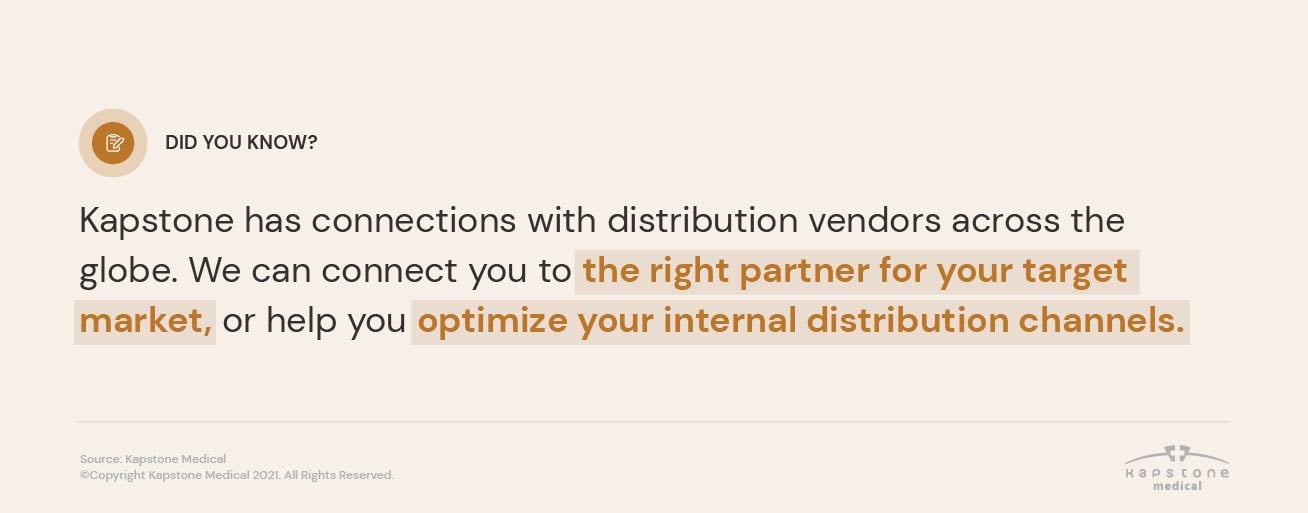Many ideas for new or improved medical devices come from observing a problem. Maybe a wearable is too heavy. Maybe there’s a better path to insertion for an implant. Maybe you’ve even thought of a first-of-its-kind treatment that will completely change outcomes for patients.
Everything starts with the idea—the solution—but that’s just the beginning. Even the best ideas don’t stand alone. Your company will need a thoughtful, comprehensive go-to-market strategy in order to position your product for commercial success in your target market(s).
In this blog, we’ll cover the unique challenges posed by bringing a medical device to market, how to address those challenges, and the ins and outs of a successful go-to-market strategy that will bring you from idea through to impact.
Bringing a Medical Device to Market
Bringing a medical device to market is a uniquely challenging proposition. Unlike consumer goods and services, among other categories, medical devices are highly regulated—and for good reason! Regulations are in place to protect consumers from risk.
In the United States, medical devices are subject to the Federal Food, Drug, and Cosmetic Act, as well as the regulations in Title 21-Code of Federal Regulations (21 CFR) Parts 1-58 and 800-1299. Other regulations may also apply in the US market; outside the US, there are both holistic and country-specific guidelines.
While compliance with these regulations is non-negotiable, it can be complicated to achieve. The team at Kapstone is well-versed in regulatory affairs in both the US and the European Union. Our regulatory experts can jump on board as early in your process as possible to ensure that your idea is optimized for regulatory clearance or approval—and can get to market. You can read more about our expertise here.
How Much Does It Cost to Bring a Medical Device to Market?
The cost can vary greatly depending on many factors including device regulation, device complexity, device novelty (and therefore testing implications and risks), raw materials, clinical trials, and supply chain, to name a few. In Kapstone's experiences, for Class II, non-510(k) exempt devices, the product development process can cost from $300,000 to over $1.5 million. A Class III (PMA) or device with clinical trials can quickly incur much more cost than this range.
Check out this blog for more information about these paths to FDA approval in the US and which could be right for your product.
How Long Does It Take to Get a Medical Device to Market?
Similar to assessing the potential cost for an entire new product development project, the timeline can greatly vary and depend on some of the same factors previously mentioned plus availability of resources and funding.
In Kapstone's experiences, for Class II, non-510(k) exempt devices, the average timeline for commercialization starting from scratch takes about 18 months. We always strive for appropriate efficiencies to increased speed to market, but never recommend short cuts that may put the device or project at risk of safety or increased timelines in the future.
What’s Included in a Go-to-Market Strategy
An effective medical device go-to-market strategy has four critical components: a clearly defined value proposition, a deep understanding of your target market and their needs, competitive intelligence, and established distribution channels.
1. Value Proposition
What market problem does your device solve?
Fundamentally, your value proposition needs to communicate the need for your product. What is the market problem, and how does your product solve it? Is your solution feasible?
Consider the following when evaluating the market need for your product and constructing your value proposition:
- Does your idea take a novel or otherwise innovative approach to solving a problem, such that it can replace a device that is already on the market or be a first-in-class solution for a life-threatening or debilitating condition (sometimes known as a “breakthrough” device)?
- Is your device substantially equivalent to a device that is already on the market, but can be constructed and sold for a lower price?
- Does your device enhance the patient or provider experience? How?
- Does your device provide additional value to patients or providers? How?
2. Target Market
Who is your device for?
Whether your device has one intended audience or several, you can optimize your go-to-market plan by customizing your positioning, marketing, and even distribution for each of those audiences.

Start by developing a persona that represents your target customer. If you have more than one target customer, develop multiple personas. Consider who the customer is (age, demographic, position, etc), where they are in the buying cycle, their needs, how and when they are likely to purchase, and any roadblocks they might encounter or questions they might have throughout the purchase journey.
These personas can provide valuable insights when it comes to constructing a marketing strategy. For example: if your target customer spends a lot of time at conventions, you probably want to include convention marketing/messaging/presentations in your market plan. But if they prefer to read about devices online, you might want to consider digital advertising.
3. Competitive Intelligence
What are competitors doing, and are they doing it well?
Because you will not launch your device into a vacuum, your go-to-market plan will need to account for competitors’ activities and potential responses.
Start by assessing competitors’ current activities and market strategies. What are they selling, and how are they selling it? Are those tactics effective? News articles, public company information, competitors’ advertisements, and customer reviews are great resources to assess.
Your go-to-market strategy can and should borrow successful tactics from competitors. While you should never directly copy a competitor’s business plan or advertising message, there are many valuable insights to be gleaned from competitive intelligence. A competitor having a presence in a certain market, or using a certain tactic is often a sign that you should, too.
Preparing for Competitor Responses
Likewise, your competitors are unlikely to be silent after you put your product on the market—particularly if you are targeting the same customer base.
When developing your strategy, consider how your competitors might react to your launch. In turn, consider the countermeasures you can take to protect yourself. Be proactive in planning your responses, as you’ll need to execute them quickly if and when competitors react as you expect them to.
4. Distribution Channels
How will you get your product into your customers’ hands?
Finally, your go-to-market strategy should include a plan for how you will distribute your product to your end users. Whether you take responsibility for distribution yourself, hire a vendor, or pursue a combination of services, this is an essential (and often neglected) step.
 Kapstone has connections with distribution vendors across the globe. We can connect you to the right partner for your target market, or help you optimize your internal distribution channels.
Kapstone has connections with distribution vendors across the globe. We can connect you to the right partner for your target market, or help you optimize your internal distribution channels.
We hope that this overview has provided some key answers as to how to create a successful medical device go-to-market strategy. Ultimately, even the best product will not sell itself. But by following these steps as thoroughly and proactively as possible, you can streamline the journey to market. Plus, you can always reach out to the team at Kapstone for help.
Contact us today to start your journey to market.


